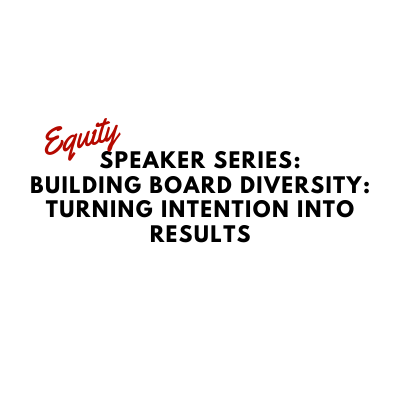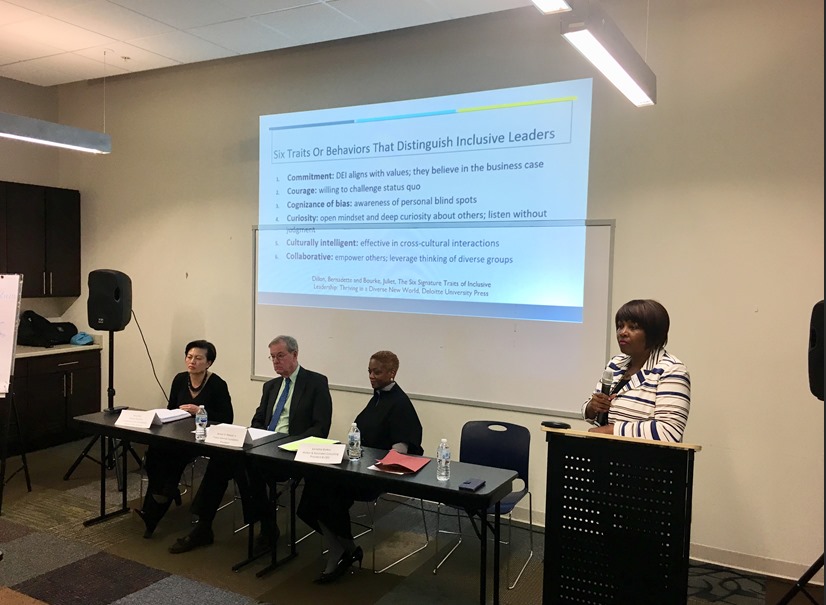10 Things to Know About Board Diversity – Lessons from “Building a Diverse Board of Directors: Turning Intention to Results”

On December 4, 2019 in partnership with the Maryland Commission on Civil Rights, Maryland Nonprofits convened a panel of experts to explore the meaning of board diversity, the challenges of creating a diverse board and what nonprofit leaders can do about it. Amy Seto, Wally Pinkard, Vernetta Walker and Carmen Marshall all have experience with boards that have transitioned from homogenous to diverse. We’ve summarized their insights and advice on this important topic.
1) Nonprofit Board of Directors are “stubbornly and overwhelmingly white.” The BoardSource study Leading with Intent: 2017 National Index of Nonprofit Board Practices, found that among Board chairs and executives from more than 1,300 nonprofit organizations survey, 84% of board members were white; and 27% of boards surveyed did not have a single person of color. Since BoardSource began tracking diversity data through this study in 1994, people of color and ethnic minorities have never represented more than 18% of board membership. This tells us that nonprofit organizations are not adapting as communities and environments change.
2) A board needs to define diversity for itself; then put it in writing. Many equate board diversity with “demographic diversity,” defined along dimensions of race, ethnicity, sexual orientation, religion, disabilities, education, language, socioeconomic status, age, and gender. However, add to that “cognitive diversity” — diversity of thought, experiences, and ways of working. Boards have to determine what kind of diversity matters to them then set an intention with goals and work toward them. Once the important diversity factors are determined, the board should develop a statement of diversity, equity and inclusion. Not only will this express commitment, it will serve a tool for the nominating committee as they consider and recruit new board members. A board diversity plan should also articulate how the board will hold themselves accountable.
3) “Diversity”, “Equity” and “Inclusion” are three different concepts. While diversity simply means “a range of differences,” equity, refers to ensuring fair treatment, equal access, and equal opportunity for advancement for all members of our society – understanding and striving to remove systematic barriers that block achievement. Inclusion means making sure people feel that they belong. When board members feel included, they are encouraged to let their opinions, backgrounds, language, ideas, ethnicity, etc. be known. And they are invited to participate and fully engage in the governing process.
4) Inclusive leaders exhibit six behaviors:
-
- Commitment – Diversity, equity and inclusion aligns with their values.
- Courage – They are willing to change status quo.
- Cognizance of Bias – They are aware of their personal blind spots.
- Curiosity – They have an open mindset. They listen without judgement.
- Culturally Intelligent – They are effective in cross-cultural interactions.
- Collaborative – They empower others and are able to leverage thinking of diverse groups.
5) Recruiting for diversity in order to “check the box” is missing the point. Although an organization can enhance its reputation by filling seats with diverse board members, to focus solely on this benefit is short-sighted at best. The purpose of building a diverse board is to promote better decision-making, to prevent blind spots in board deliberation, to integrate equity throughout the workplace, and to gain access to different community resources, including a different pool of donors.
6) Board recruitment and leadership development must be intentional. When you identify a potential board member, it’s important to take time to fully consider the needs of the nonprofit and the needs of the candidate. Maryland Nonprofits’ Composition Analysis Quick Tip Resource and Board Composition Grid will help identify the organization’s needs. However, fully understanding how a person can meaningfully contribute to the organization and identifying the best role and opportunities for future leadership is one of the most important factors in achieving diversity and inclusion. To do this, you must have a meaningful conversation with your board prospect.
7) Relationships matter. Keeping board members engaged also depends on the strength of board relationships. Board members must be open to sharing power and to avoiding board cliques. Existing board members should welcome new board members, take time to get to know them, and should provide opportunities for board members to contribute. When people contribute, they feel empowered. Developing a “buddy system” where existing board members mentor and guide new board members can go a long way towards making a new board member feel as though they belong.
8) Fundraising doesn’t suffer as a result of diversity. A 2018 study by the Lily Family School of Philanthropy found that while there were no significant findings among boards with higher percentages of people of color overall, boards that have a higher percentage of Asians were rated higher by their CEOs for their fundraising performance. Boards with higher percentages of women tend to have more board member engagement, higher fundraising engagement, and higher advocacy engagement.
9) Achieving board diversity is a gradual process. Achieving board diversity starts with the board leadership supported by “champion” board members, with the conversation always structured around what the organization needs. If the proper tone is set at the top, it creates an authorizing environment that allows for board members and staff to pursue relationships that could help identify potential board members. If board members are resistant to change, the board may find it easier to begin with discussions about inclusiveness first; then move on to board diversity and equity goals. Change doesn’t happen overnight. And staff/board culture can shift even if board composition doesn’t.
10) Think beyond current networks to diversify board members. As highlighted Board Source’s resource, “Taking Action on Board Diversity,” “If your board is lacking the diversity you seek, you may find that relying on the personal networks of current board members to identify new board candidates will only reinforce that challenge.” This resource and the panel suggest several ways to overcome this challenge:
-
- Engage in deep networking with community organizations;
- Tap your volunteer network to identify potential leaders;
- Ask members of your current or past client community, who they would recommend as a board member;
- Post your board position on the Maryland Nonprofits job board or a similar service
- Use a nonprofit board matching service
- Host conferences/events to attract diverse individuals
Your board composition influences how your organization is represented to the public and will make all the difference in how effective you can be at creating the change for your communities. Building board diversity doesn’t have to be an urgent task “fill in the gaps.” Instead, if you approach the process with thoughtful intention with an eye toward embedding equity, inclusion and diversity values into the board’s work, over time, you can shift your board composition and achieve the appropriate mix of talent, diversity, and connections that advance the organization’s mission delivers service to the community equitably.

The panelists from Building Board Diversity, from left to right, Amy Seto, Wally Pinkard, Vernetta Walker and Carmen Marshall
